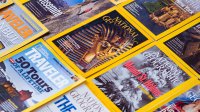The Benefits of Incorporating Print Magazines Into English Class
Reading print magazines can spark curiosity among students and encourage them to make unexpected connections.
Your content has been saved!
Go to My Saved Content.Many adults have childhood memories of leafing through print editions of National Geographic, LIFE, or Time magazine in their home, at school, and in doctors’ offices. Due to the ubiquity of digital devices and a steady decline in print subscriptions, very few of today’s K–12 students have had that experience.
Print magazines offer a unique synthesis of text and images that makes them an appealing option for reluctant readers. Teachers have the opportunity to incorporate this rich, diverse resource into daily instruction and provide students with a meaningful reading experience that promotes curiosity.
For the last several years, I have incorporated a daily, 15-minute silent-reading time at the beginning of my 65-minute regular English 11 class periods. I chose to have students spend this time exploring a broad variety of print magazines I acquired from the media center, our home, and other sources.
Strewn about the tables in my classroom were titles ranging from Entrepreneur and Bon Appetit to Leatherneck, a magazine published by the Marine Corps Association. This daily magazine-reading time was one of the more valuable learning activities that took place in those English classes.
The Joy of Organic Curiosity
What I most appreciated about the daily student engagement with magazines was seeing students reach the point of genuine, organic engagement even though I never assigned follow-up activities.
Not surprisingly, it took a few days for some students to move beyond their initial impression of static print magazines as boring. Within a couple of weeks, however, these complaints not only subsided but were replaced with quiet conversations among students about what they had read. When a complaint did occasionally arise after the first two weeks, it was about the 15-minute reading time being too short.
Students began recommending issues and articles to one another.
The most popular single copy was an issue of National Geographic containing a feature story about a young woman who had received a face transplant after a failed suicide attempt left her disfigured. Students were touched by the human element of the story and fascinated by the complexities of the medical procedure. Other popular stories included one about dogs serving in combat units and one about parasites that turn insects into “zombies” in order to spread their spores.
Serendipity and Unexpected Connections
One of the greatest advantages that print magazines have over online media is the freedom from algorithmic customization. Readers who consume media on devices are—knowingly or not—trapped in a world customized to their own preferences. Readers who flip through a print magazine have the opportunity to stumble upon stories they might have never seen while living within their filter bubble. These unexpected encounters challenge the brain to make sense of new insights.
I sourced my magazine collection primarily from the school media center and our family magazine subscriptions. I would refresh the collection roughly every two months. Although I could have sought a more active turnover cycle, I noticed that many of the students benefited from repeated reading of single issues.
For students who are accustomed to scrolling through dozens if not hundreds of headlines, captions, and memes each day, there seemed to be comfort in the familiarity of unchanging articles and unclickable images that they’d seen before. Like students who have read the Harry Potter series multiple times, students developed a sense of ownership of certain magazines.
These hard-to-measure aspects of emotional investment and physical connectedness are facets of literacy that are absent in the experience of people who consume most of their text on screens.
The Issue of Standards
While I was incorporating this daily-magazine-reading practice in my classes, I had the good fortune to be teaching at a grade level where the pressure to link every minute of English class time to a state standard was less intense than it is for teachers in grades with high-stakes standardized tests. I believe strongly that the benefits of this daily activity would have decreased substantially if I had felt obligated to assign follow-up work.
My primary intent with this activity was simply to immerse the students daily in the act of reading for reading’s sake—”just” exploring text and images in order to learn something new.
For teachers who find themselves in more standards-focused circumstances, there are plenty of small activities that could be assigned related to daily magazine reading. Numerous literacy standards could easily be linked to this daily routine—particularly standards dealing with comprehension, persuasion, reflection, and vocabulary building.
One caveat teachers should consider is that any follow-up assignments should be kept as lean as possible and assigned only as frequently as necessary if the hope is to maintain positive attitudes about the daily practice.
The Greatest Benefit
The most valuable outcome of daily magazine-reading time is likely to be an increase in genuine, unfettered curiosity—the type of intellectual hunger that turns young students into lifelong learners with a desire to understand the complexity of our world. Students who are given the opportunity daily to explore quality periodicals will likely settle into the practice and benefit from it.
